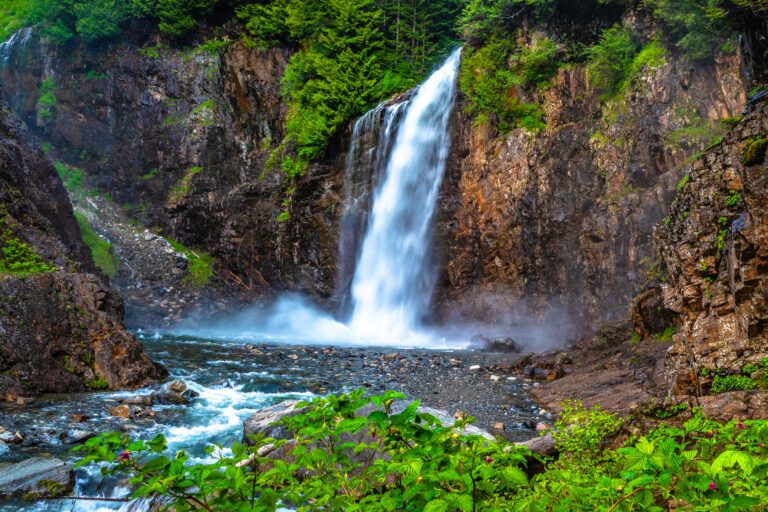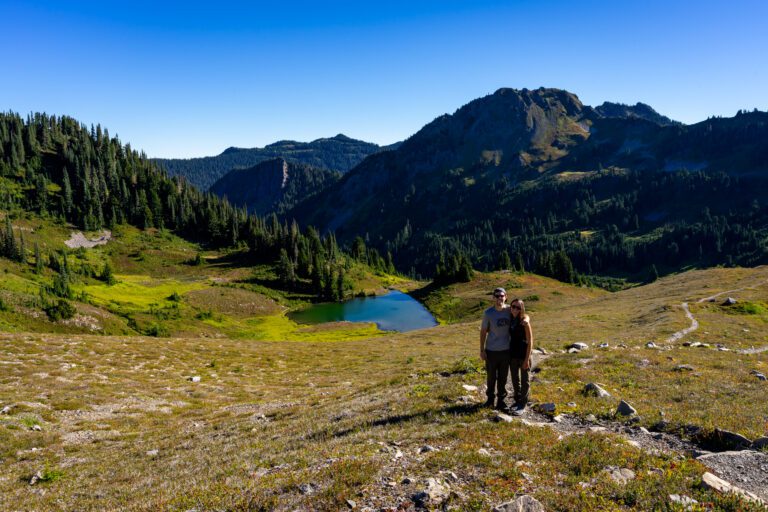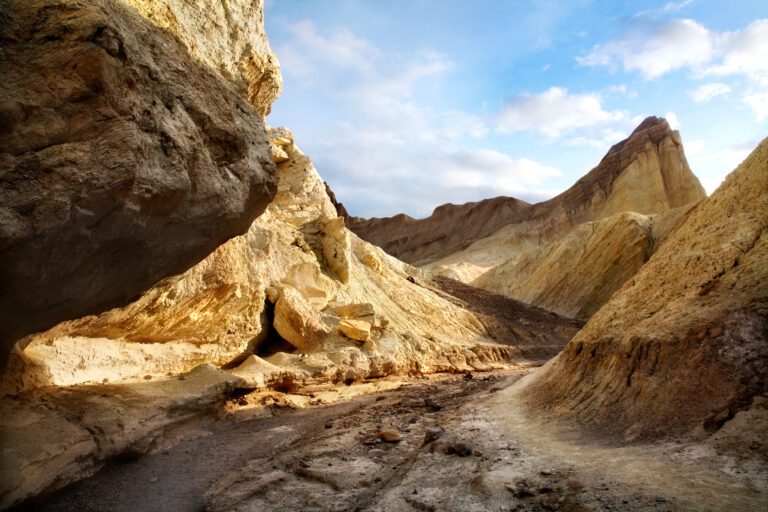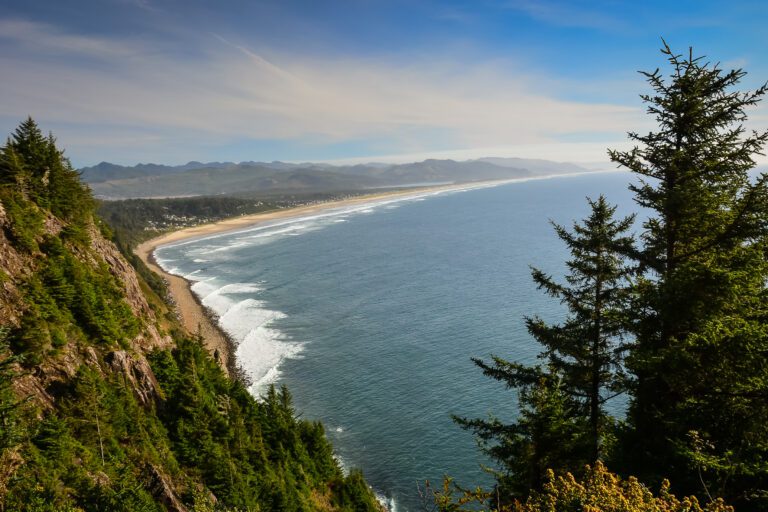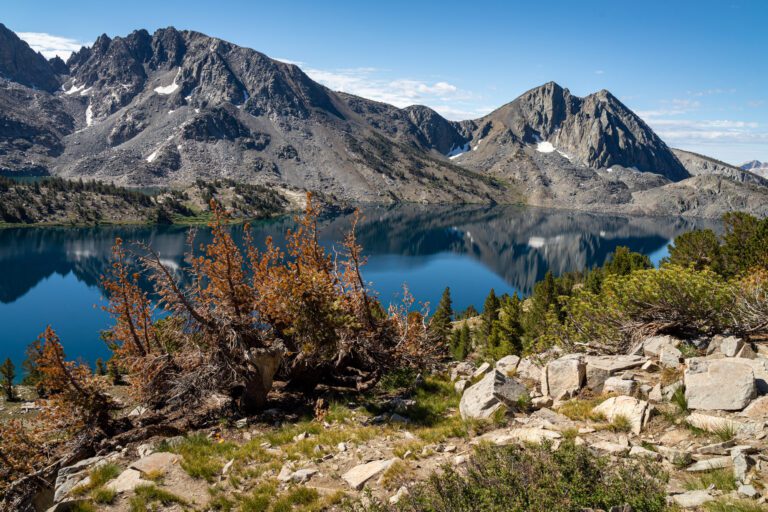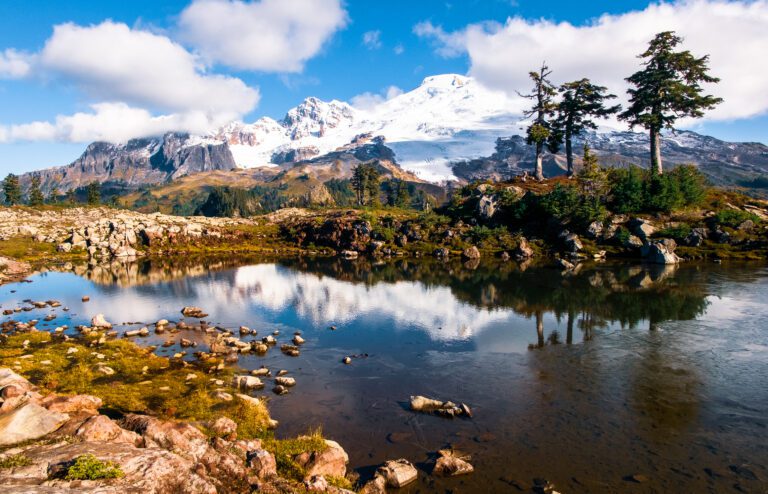What to Wear Hiking: How to Choose the Right Hiking Clothes
Pants vs. leggings. Cotton vs. wool. Fleece. Down jackets. If you’re wondering what to wear hiking, you’re in the right place. We’re going to give you our picks for what hiking clothes to have in your arsenal for hiking in all seasons on the West Coast (except snow hiking, which requires a whole other blog post), and how to put them together depending on what season you’re hiking in, and where you’re hiking.
It’s worth noting that you can totally get out there and hike in your basketball shorts, old high school P.E. shirt, and your Nikes, but it might not be the most comfortable (or safest) experience. You don’t necessarily need special hiking clothes, but they certainly help.
As someone from the Pacific Northwest, I believe that you can hike in any weather as long as you’re prepared with the right clothing. And we’re here to use our experience hiking hundreds of miles up and down the West Coast to help you decide what the “right clothing” is for you.
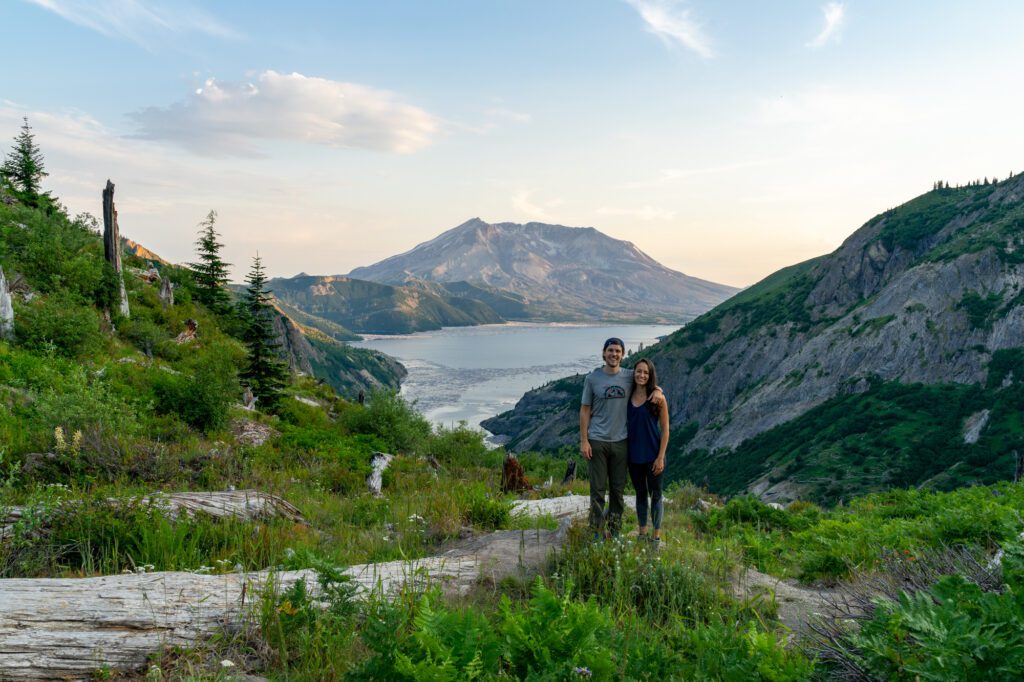
Disclaimer: Some of the links below are affiliate links, which means that if you click on one and purchase something, we make a small portion of the sale at no additional cost to you. It goes without saying that we would never recommend something we wouldn’t use or do ourselves.
What to Wear Hiking: The Basic Principles
Before we get into specific pieces of clothing, let’s quickly cover some basic principles that will help you stay comfortable on a hike.
- Avoid cotton clothing. I know I just got done saying “you can wear anything,” but that doesn’t mean you should. Avoid cotton at all costs, especially if it’s going to be either hot or raining. Cotton takes FOREVER to dry, so you’re going to be better off with polyester or something of that nature. This is especially important for pieces that are in contact with your skin, like underwear and socks. Nobody likes hiking in damp socks.
- Layers are your friend. Maybe the most important principle of all to remember is that layering is key. Depending on where and when you’re hiking, it’s likely that temperatures will change, either as you climb in elevation, or as the sun gets higher (or lower) in the sky. Alysha and I often stop multiple times to peel off layers as we’re hiking. We routinely yell “I need to strip!” to each other and make all the hikers within earshot uncomfortable.
- You’ll need a daypack. You’ll want a daypack that you can stuff your unused layers into as you peel them off.
- Leave the jeans at home. Not only are jeans cotton, which violates the first principle above, they’re also downright uncomfortable to hike in. You’re going to want something more stretchy, like hiking pants, leggings, or track pants. Ladies, make sure your leggings are sturdy enough to handle some scrambling or snags by tree branches without ripping.
- Be prepared – conditions can change FAST. When you’re hiking, particularly at higher elevations, the weather can change in mere minutes. It can go from hot and sunny to hail the size of golf balls before you have a chance to find a tree to hide under. We recommend packing more than you think you’ll need – I always have a rain jacket and pair of rain pants in the bottom of my hiking backpack – and checking the weather before you leave.
What to Wear Hiking: Our Complete List
Now that you’ve got the principles down, let’s get into specific recommendations to help you stay cool and dry when you’re hiking in the summer (or warm and dry when you’re hiking in the winter).
Hiking Tops
Remember that layering is your friend here. The options below are things that you should have in your collection of hiking clothes, and depending on the hike you’re doing, the weather, and your desired level of comfort, you can pick and choose what to bring with you on that particular day.
Moisture-wicking T-shirt
Depending on what you prefer, this can be either a short sleeve t-shirt, or a long sleeve shirt. The latter will give you more sun protection too, which is an added bonus. Whatever you choose, make sure it’s not cotton.
You’ll find us in the Patagonia Capilene t-shirts on trails around the world. It’s lightweight, offers sun protection, and has held up great after literally hundreds of miles on the trail. They come in men’s and women’s versions, along with all sorts of different sleeve lengths. They’re pricier than some of the other options out there, but we think the combination of fit, durability, and functionality make them worth it.
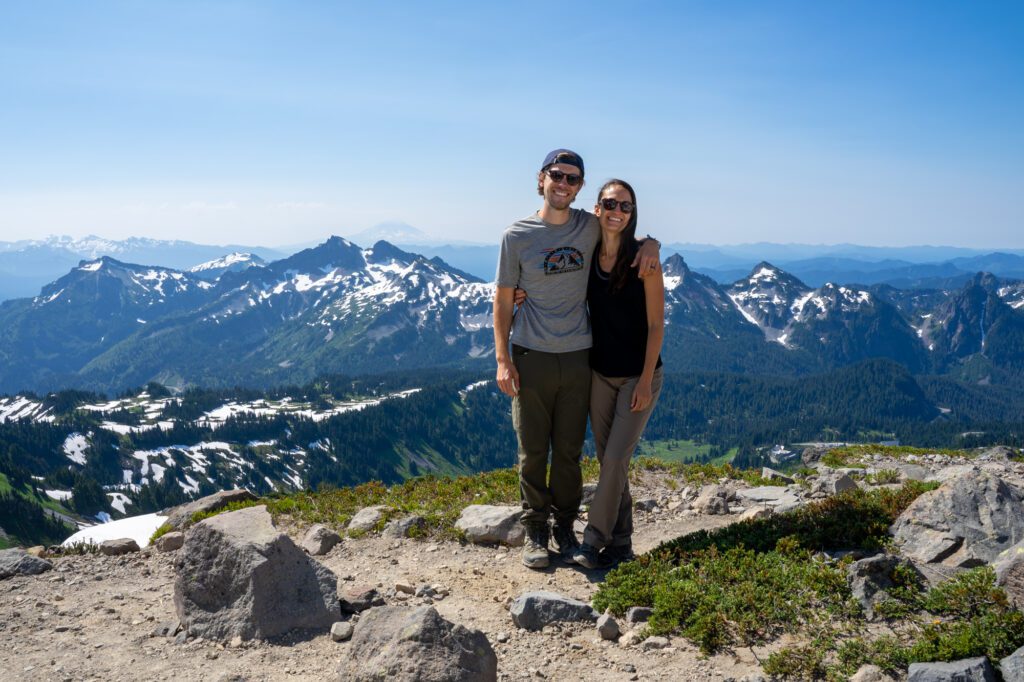
If you’re on a budget, check out the REI Sahara line. They don’t fit as well, but they offer some of the same benefits at a lower price.
Lightweight Pullover
This is probably the crucial piece that we use most often. On basically every hike we do, we start early, which means it’s going to be cooler. Sometimes we’ll wear even more layers if it’s really cold, but this is the one we end up wearing most often.
You’re going to want to have a lightweight pullover in your hiking wardrobe for a couple reasons. First, for warmth at the start of a hike on cool mornings. Second, for sun protection on the way back down on a hot summer day. Third, as an extra layer if the weather turns and you end up in an unexpected rain or windstorm.
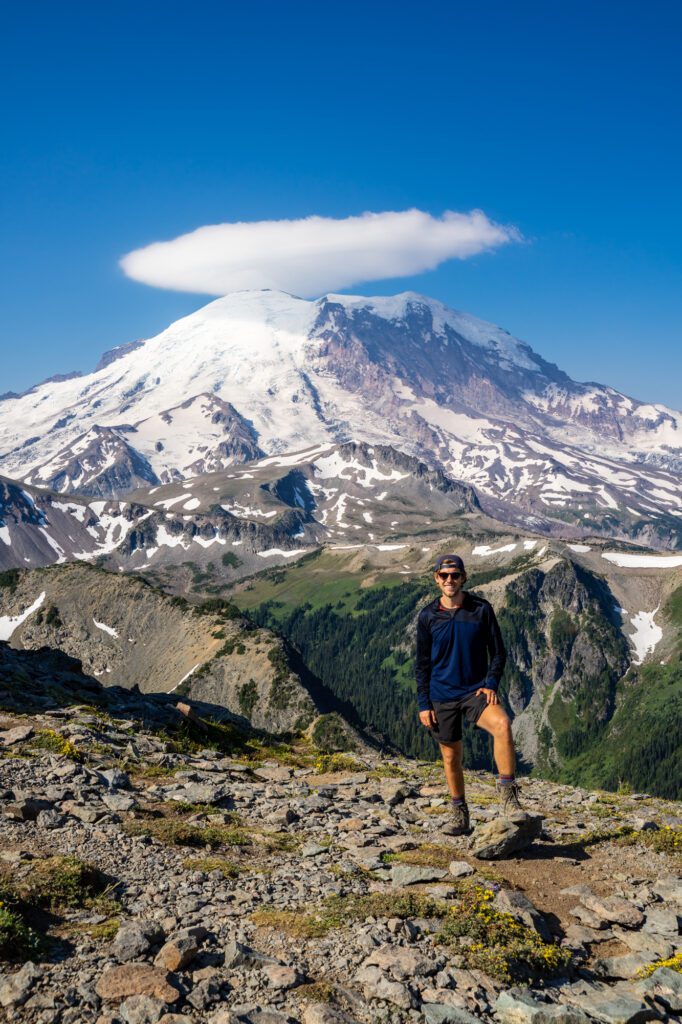
I love the Brooks Running Dash ½ Zip (women’s version here), and basically wear it on every hike we go on these days. It’s lightweight, fits great, and is plenty warm as a layering piece, but cool enough for the start of a hike on a warm day with excellent breathability.
Heavier Fleece
For hiking in the spring, fall, and winter, it’s generally going to be colder. Depending on where you are, MUCH colder. A heavier fleece jacket is going to be your best friend on those days.
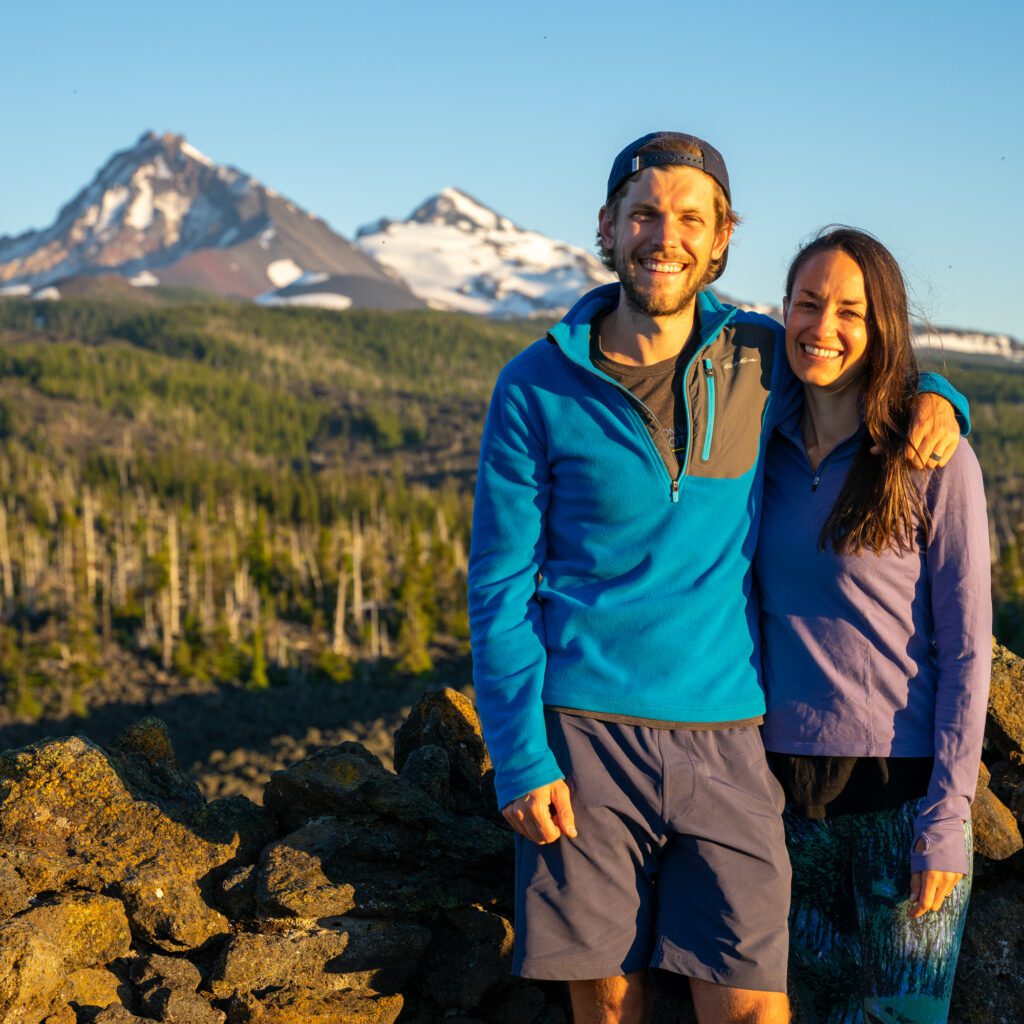
We prefer half zip pullovers, but it really comes down to personal preference whether you want a half zip or a full zip fleece. North Face makes some solid fleece jackets, and REI’s house brand is again a good budget option with their Hyperaxis Fleece Jacket.
Rain Jacket
A good rain jacket is an essential piece of hiking gear, especially if you’re hiking in Washington State or Oregon, and it basically never leaves my pack.
One thing to keep in mind is that “water-resistant” and “waterproof” mean two completely different things, something I learned the hard way in a downpour in New Zealand. Imagine my surprise when my rain jacket quickly became soaked! It was like Ross and the condoms in that one Friends episode, where he’s incredulous that condoms aren’t 100% effective. “You mean this rain jacket isn’t actually waterproof? WHY DON’T THEY PUT THAT ON THE PACKAGE?!”
The point is, if you want to stay completely dry even in the heaviest downpour, you’ll need a rain jacket that explicitly says “waterproof.”
Here’s the hiking outfit that Alysha – a California girl through-and-through – opts for when it’s sprinkling outside on hikes in the Pacific Northwest.
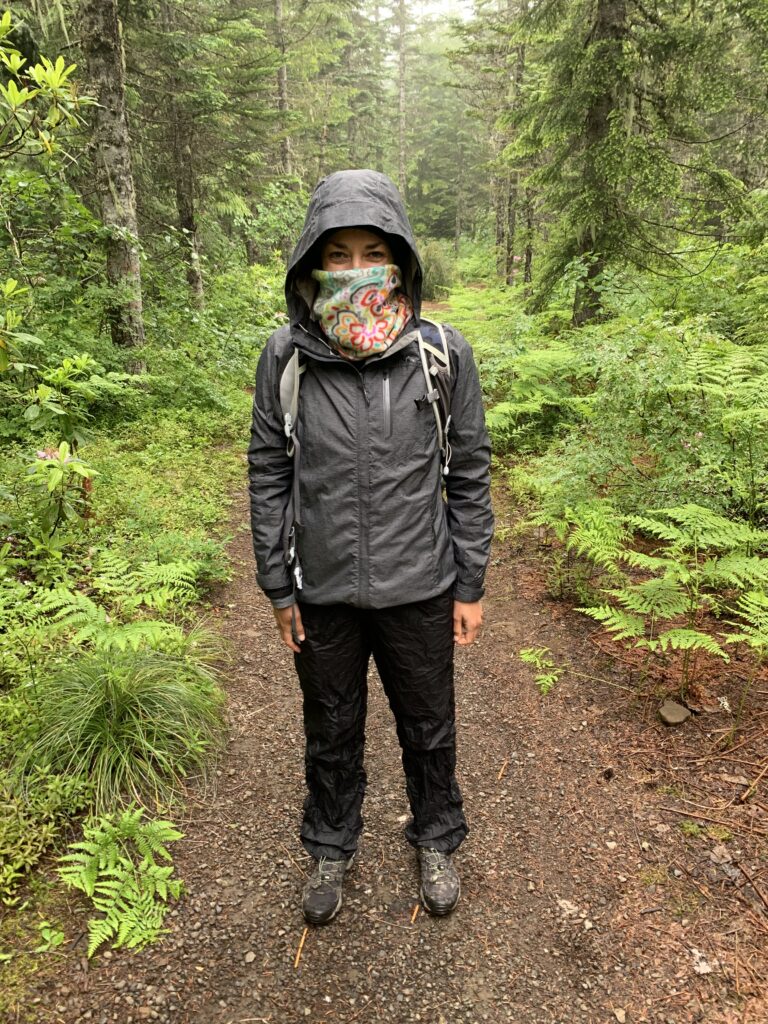
I have the Columbia Watertight II jacket, which is a solid budget option (women’s version is the Arcadia Jacket) that I would say is missing a few bells and whistles, but gets the job done.
A worthy upgrade would be the Black Diamond Stormline Stretch Rain Shell, which is what I’m going to be buying when I need a new rain jacket.
Alysha has an earlier version of the REI Rainier jacket, which she likes. Plus, it packs down super small!
Packable Insulated Jacket
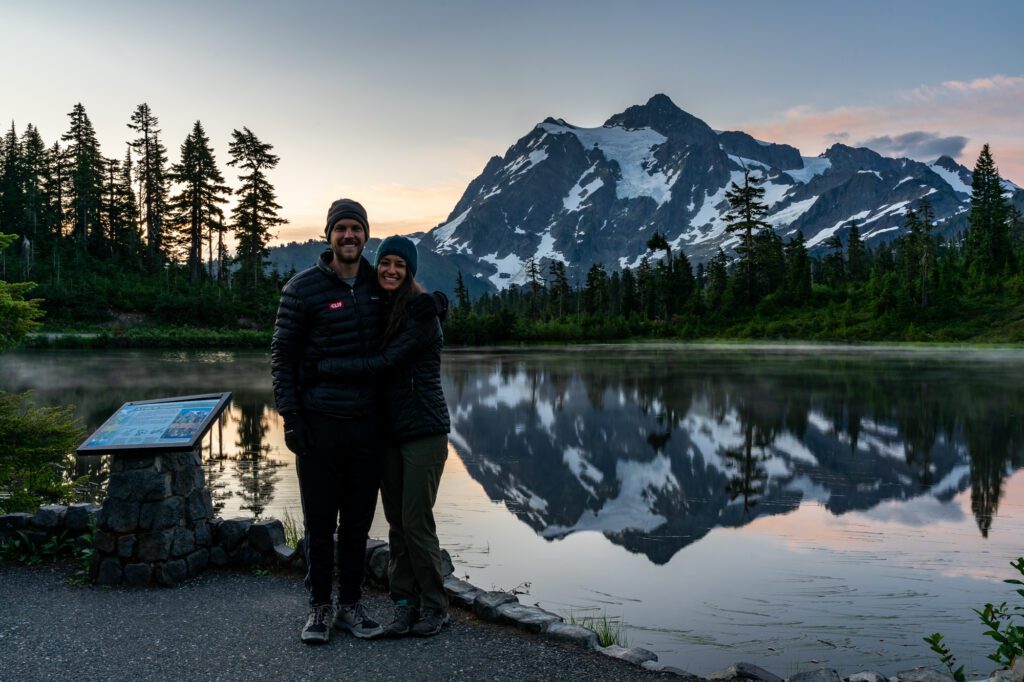
Recently, we’ve been doing more shoulder-season and winter hiking in cooler places, like Utah and the Pacific Northwest, where it’s often in the 30’s when we start our hikes. Which is too cold for our blood.
A packable insulated jacket is essential in those conditions. A down jacket, which is going to keep you much warmer, would be preferable.
I LOVE my Patagonia Down Sweater (though I would pay the premium for the hooded version in the future). I wear it basically every day in the winter, whether we’re hiking or not, and it packs down plenty to fit into my daypack. We also like the Patagonia Nano-Puff, which is not as warm as down, but is still a good lightweight layer.
Hiking Bottoms
What you wear on the bottom depends more on personal preference and weather than what you wear on top.
For example, Alysha is generally more comfortable hiking in leggings in mild weather, opts for shorts in hot weather, and layers long underwear under hiking pants in cooler weather.
Here are the main pieces that we think you should have in your arsenal to choose from when you’re planning a hiking adventure.
Hiking Pants
I have spent years trying to find hiking pants that are lightweight and stretchy, but also fit well – most mens hiking pants end up being like bell bottoms around the ankles.
Here are our picks for hiking pants for men and women.
- Outdoor Research Ferrosi: I, Matt, have two pairs of these pants, and would buy a third, fourth, and fifth. They’re stretchy and comfortable for hiking. They’ve got nice elastic bands around the ankles. I’ve worn them for hundreds of miles, and likely will wear them for hundreds more. Here is the women’s version.
- Title Nine: Alysha loves Title Nine, which is a brand started by women, for women, and they make some solid hiking clothing. She has a pair of the Clamber Hiking Pants, and that’s what you’ll find her in when she’s not wearing leggings.
- We’ve heard good things about the Patagonia Quandary pants and Prana hiking pants, but haven’t gotten around to personally trying them just yet.
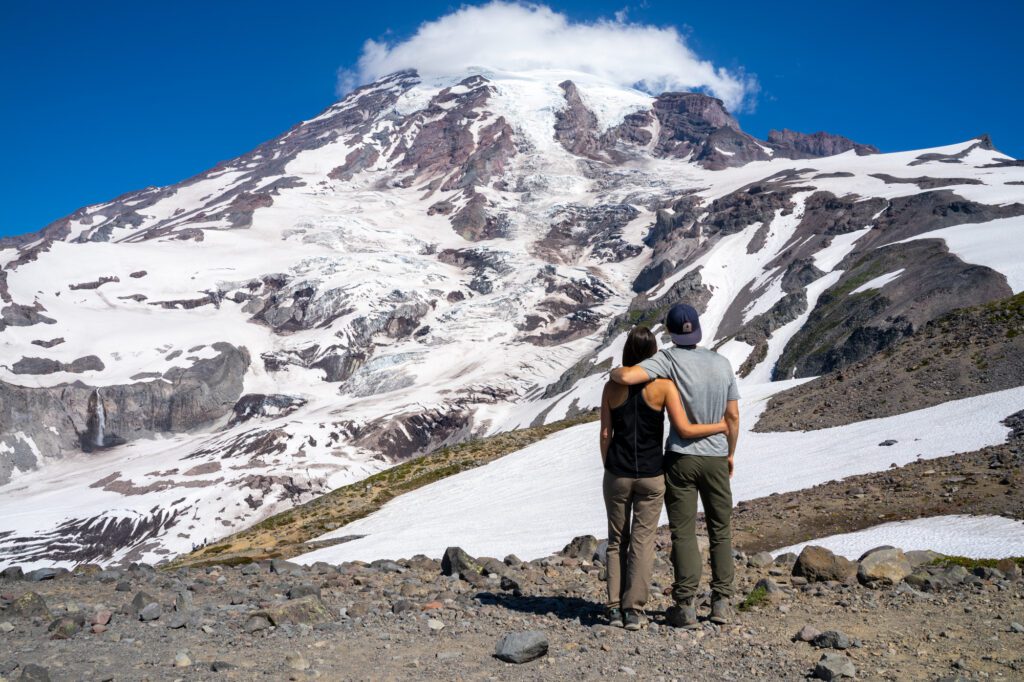
Leggings
Alysha here! Matt doesn’t have much experience with hiking leggings, so I’m here to give my thoughts.
In all honesty, when I’m in the mood to opt for leggings on the trail I usually throw on my favorite pair that I also wear to the gym – nothing fancy here. I find I’m happiest on the trail in leggings in mild temperatures and on shorter hikes.
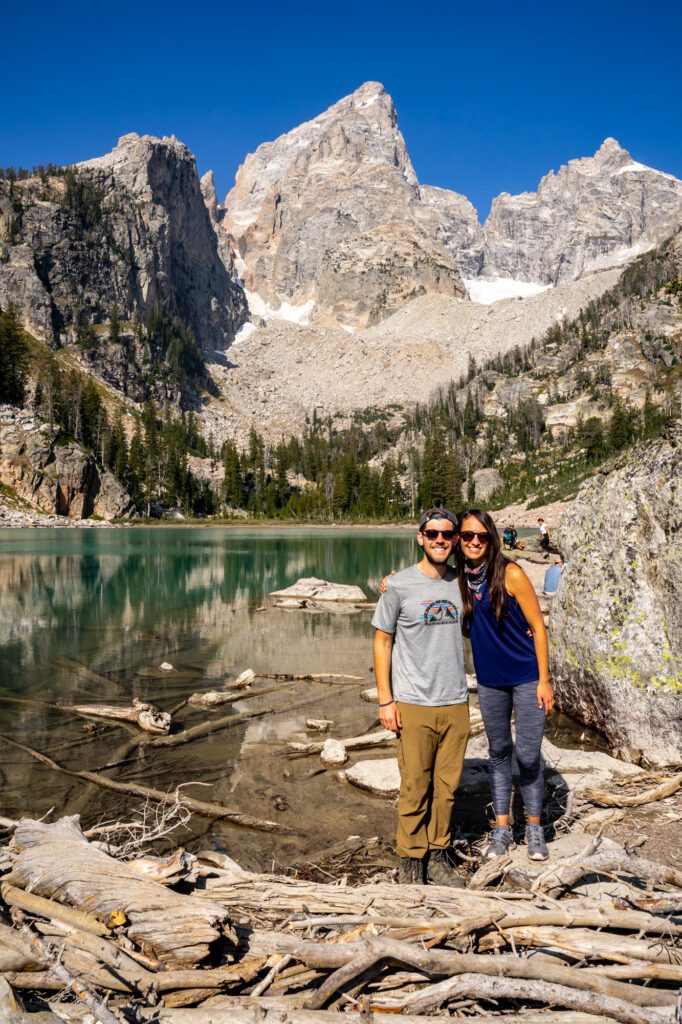
My only suggestions would be to make sure your leggings are thick and long enough (I usually go for ankle length) to protect against branches and rocks in the off chance that your hike turns into a scramble. Also, you probably don’t want to be giving an unintentional show to the person behind you on the trail with a pair so thin they become see-through at the slightest bend.
Lastly, leggings with pockets are a nice bonus, but not necessary since you’ll have your daypack.
Hiking Shorts
I don’t have anything special to say here, to be frank. Pick a pair of shorts that are non-cotton, quick-dry, and get out there! Pockets are useful, too.
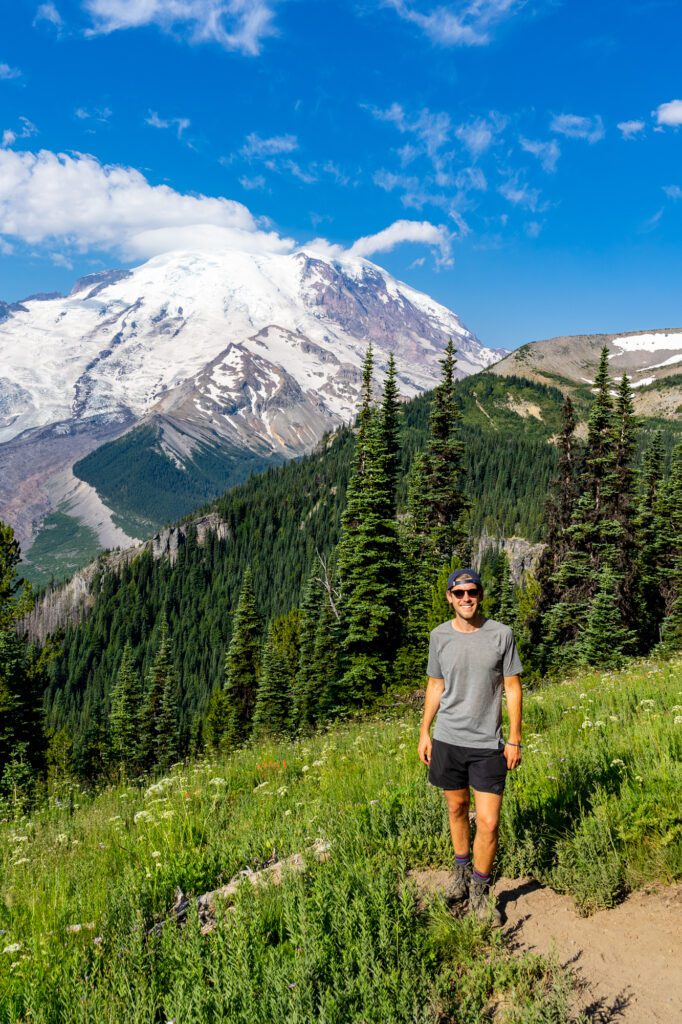
Underwear
Look, we’re not here to give you advice on what undies to wear, because that would be weird. It all comes down to personal preference. Whatever underwear you choose, make sure they’re not cotton!
Long Underwear
In especially cold weather, like when we’re hiking in Joshua Tree in late November, we usually add a layer of long underwear under our hiking pants (Alysha even wears them under her leggings) for an extra layer of warmth.
The main thing to look for here is non-cotton, which most of them are. Synthetic fabrics are going to be lightweight and cooling, but they tend to get stinky fairly quickly if you’re sweating in them on a hike. Wool solves that problem, but at a higher price point.
Fabric weight also matters here – REI makes great base layers ranging from lightweight to heavyweight. The heavier the fabric, the warmer it will be. But it will also be less breathable and not as comfortable to wear on a hike. We’d recommend sticking with either lightweight or midweight for the vast majority of people.
If you want to upgrade to merino wool, go with Smartwool base layers.
What to Wear On Your Feet
There are really only two pieces of equipment that you need to worry about here (at least for 99% of hikers), and they’re both equally important for comfort and safety.
Hiking Boots
Hiking boots are one of the most important parts of your hiking wardrobe, not just for comfort, but also for safety. You’ll want to ditch the running shoes and invest in a solid pair of hiking boots for the traction and support when you start doing some of the tougher hikes on the West Coast, like the Enchantments in Washington, or some of the trails around Mt. Hood in Oregon.
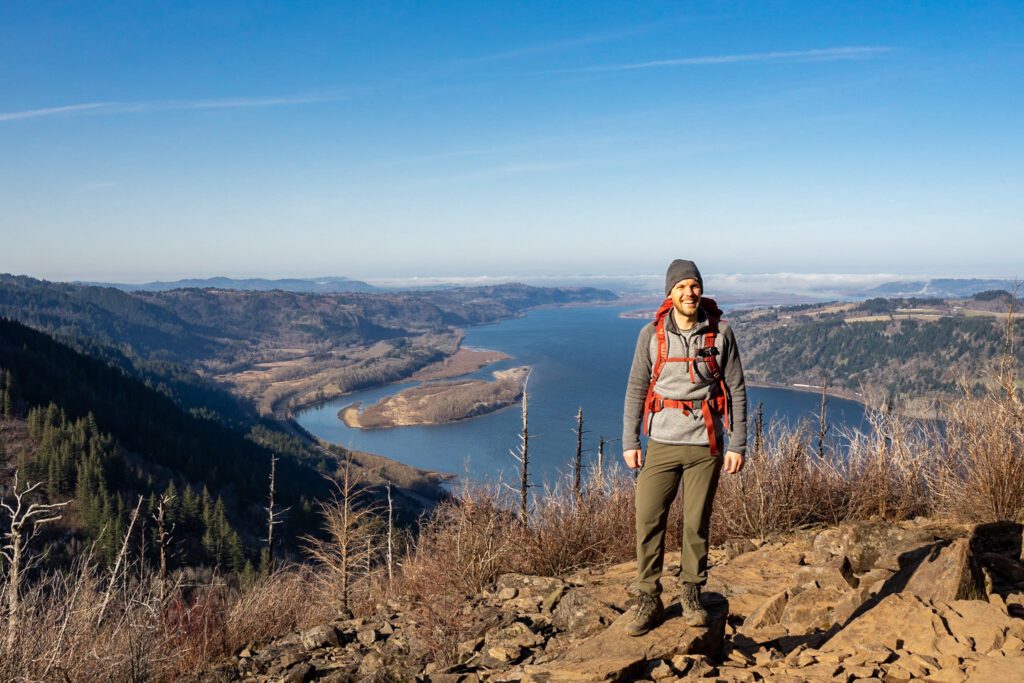
We think they’re so important that we have a whole guide to the best budget hiking boots to help you find the perfect pair.
There are a couple things you should be looking for here:
- Waterproof vs. breathable: As a general rule, waterproof boots are going to be less breathable. Which side of the tradeoff you fall on depends on where you’re primarily going to be hiking. Both of us fall on the waterproof side because it means we don’t have to play the game where you jump from rock to rock as you try to cross the big muddy section, which happens fairly often if you’re hiking in Oregon.
- Lightweight vs. more support: This is another spectrum to think about. Some boots are going to be essentially high-top running shoes in terms of their construction, while there are other boots that are heavy duty, ready for a thirty mile backpacking trip and then some.
- Material: This really only matters for the purposes of breaking in a new pair of boots. Leather hiking boots are going to take a little bit more breaking in, while some of the Gore-Tex and other synthetic materials are generally good to go right out of the box.
Alysha has the Columbia Newton Ridge waterproof boots, and likes them. We saw hundreds of people wearing them over the course of our 2020 road trip, and the brown pair with red laces are super stylish. They’re a really, really solid pair of affordable hiking boots.
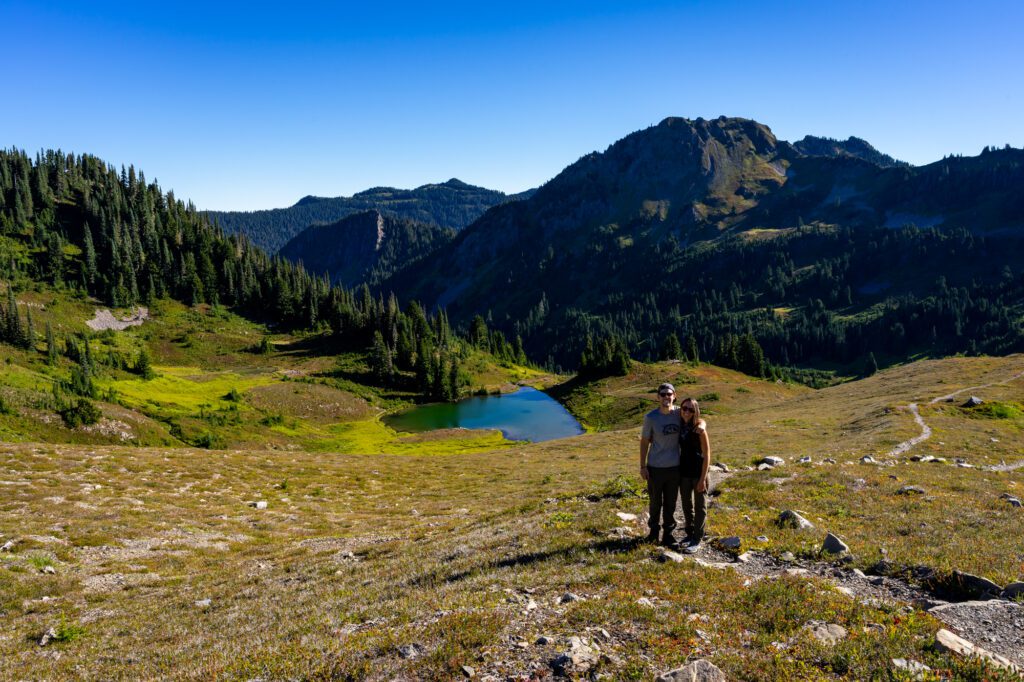
Matt likes the Keen Targhees, which are a nice balance of lightweight but supportive (definitely not the lightest boots out there, don’t get me wrong). Plus, they have a nice wide toe box, which is nice for people with wider feet. They’ve been around the world and back with him, and have only just started to see wear and tear after over five years.
For heavier boots made for backpacking, go with the Salomon Quest 4 GTX. Matt has them, and wears them on longer day hikes or overnight backpacking trips. They’re heavyweight, sturdy, and have tons of support.
Hiking Socks
Hiking socks might be the most underrated piece of hiking clothing on this list. But when you’re hiking 12 miles with 4,000 feet of elevation gain in the summer, you’re quickly going to realize that your Nike crew socks aren’t cutting it.
Good, sturdy wool hiking socks will prevent blisters and help avoid the feeling of hiking in damp socks by wicking sweat and drying fast.
Matt generally opts for long hiking socks with both hiking boots and hiking shoes, while Alysha opts for crew socks when she’s wearing her hiking shoes.
We have three favorite brands here, and all three will do wonders for your feet on long hikes.
- Darn Tough: These are my favorite. They’re sturdy and come with a lifetime guarantee, they come in all sorts of different lengths, weights, and patterns, and they’re made right here in the USA (in Vermont!). They do one thing, and they do it REALLY well.
- Smartwool: They make all sorts of wool hiking socks, from low cut to crew, from lightweight to heavyweight backpacking socks, and more. I have multiple pairs of them, and I wholeheartedly recommend them.
- Stance Hiking Socks: I like Stance socks in general for their cool designs, and I have a pair of their hiking socks that has held up really well over the course of hundreds of miles. However, they’re not wool – they’re synthetic. Some of their hiking socks are cotton blends, so make sure that whatever hiking socks you’re buying are 100% synthetic.
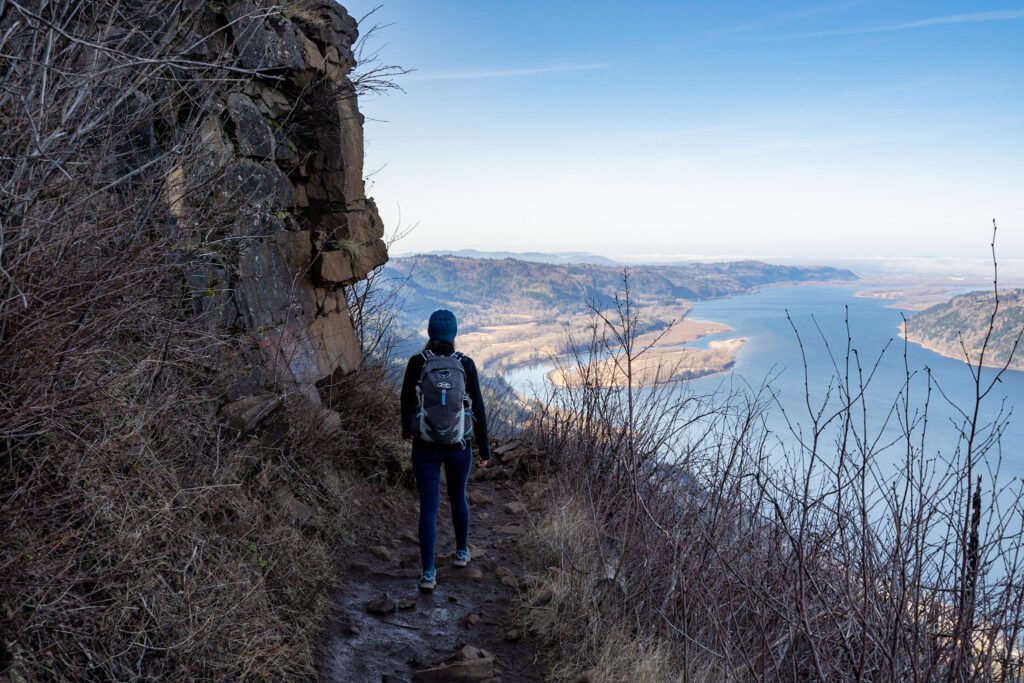
Other Stuff to Wear
Here are some other miscellaneous things that don’t quite fit in the categories above, but are still things to wear when you’re hiking.
- Hats: There are two types of hats to think about for hiking. First is sun hats for hiking in the desert or at high elevations. When you’re in the desert or hiking at high elevations, there’s probably not going to be much shade, and a sun hat will help give you some extra protection from the sun. Second of all, beanies. In the winter, you gotta protect those ears!
- Gloves: For those chilly winter mornings on the trail, we almost always wear gloves. Find the right gloves for you here.
- Sunglasses: We wear our Sunski sunglasses with pride! They make all shapes, sizes, and colors, and we’ve taken them around the world with us. We both have AT LEAST one pair (Matt has two. Why, you ask? Great question).
- Sunscreen: Wear sunscreen when you hike! We love Sun Bum, and pretty much use their sunscreen exclusively at this point. Mainly because we like smelling like coconuts when we hike, and it’s less greasy than a lot of the other options on the market. We have used many bottles of their SPF 50 and their face sunscreen, and will probably use many more.
- A Buff: Good for extra sun protection, wind protection on particularly windy summits, and cooling on hot days. Here’s the original Buff.
What to Wear in Different Seasons
Now that you have our picks for what should be in your wardrobe, here’s how it might come together in different seasons. Of course, it totally depends on where you live and where you’re hiking, so take these lists with a grain of salt.
What to Wear Hiking in the Summer
If you’re hiking in the summer, you’re most likely not going to experience too much rain. However, you are going to run into lots of sun, so you’ll want to make sure you have plenty of sun protection to go around.
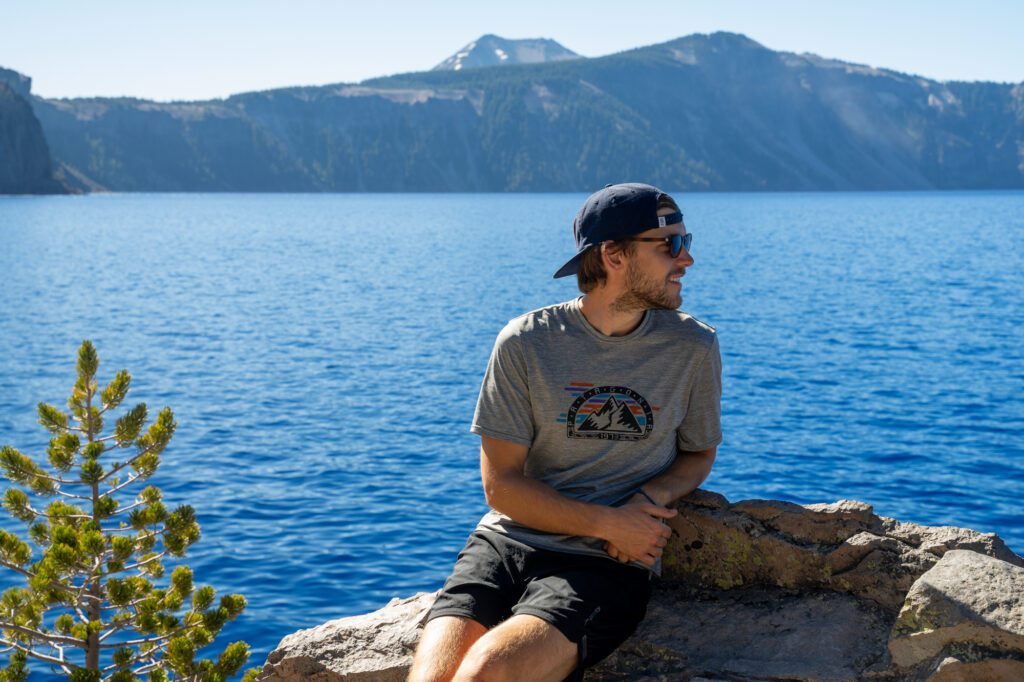
- Moisture-wicking t-shirt
- Lightweight pullover
- Hiking shorts
- Hiking socks
- Hiking boots
- Sun hat
- Sunscreen
- A Buff
- Sunglasses
What to Wear in the Fall & Spring
In the fall and spring, you might still run into sun, but weather is going to be more variable, which means you’ll need to be prepared for a wider range of weather.
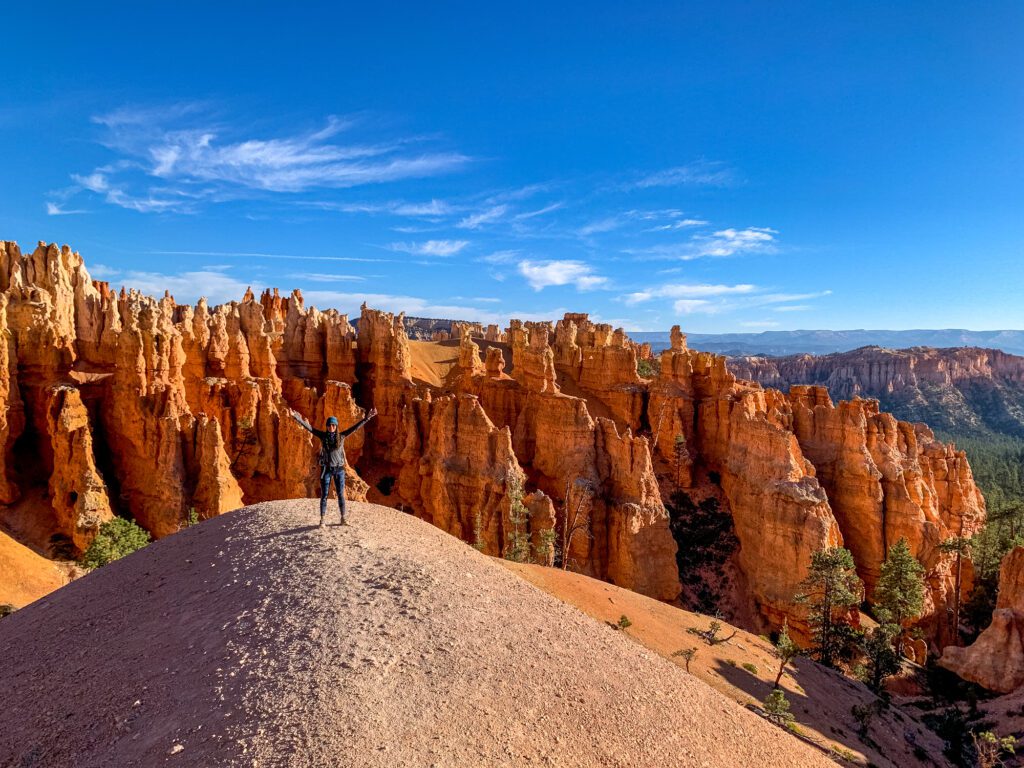
- Moisture-wicking t-shirt
- Lightweight pullover
- Packable down Jacket
- Hiking pants or leggings
- Rain pants
- Rain jacket
- Hiking socks
- Hiking boots
- Sun hat / beanie
- Gloves (if cold)
- Sunscreen
- A Buff
- Sunglasses
What to Wear in the Winter
If you’re wondering what to wear hiking in the winter, it boils down to the fact that you’re going to want to pack ALL of the layers. And plenty of rain gear, especially if you’re in the Pacific Northwest.
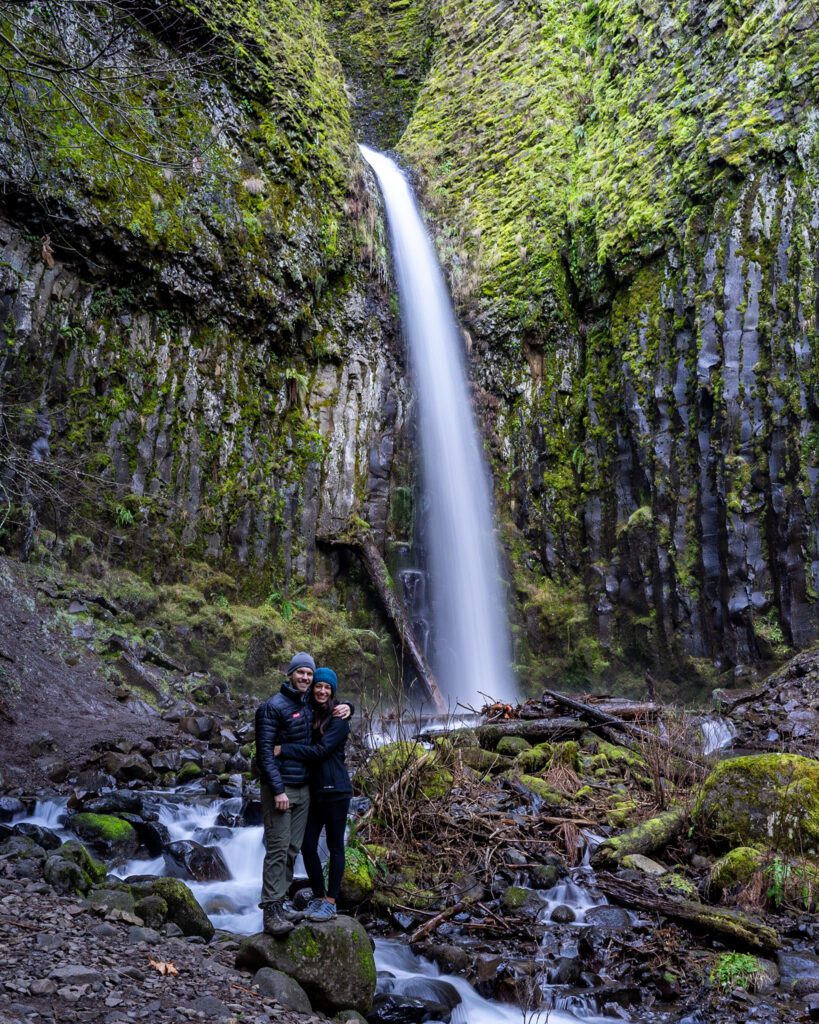
- Moisture-wicking t-shirt
- Lightweight pullover
- Heavier fleece
- Packable Down Jacket
- Hiking pants or leggings
- Long underwear
- Rain pants
- Rain jacket
- Hiking socks
- Hiking boots
- Beanie
- Gloves (if cold)
- A Buff

